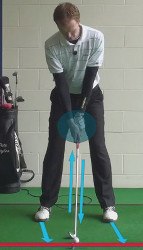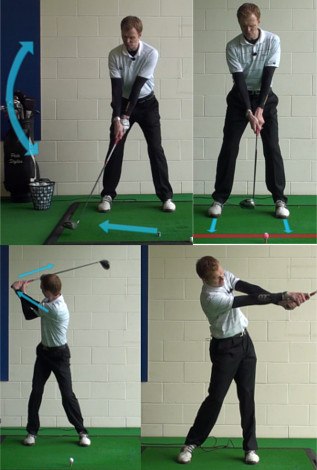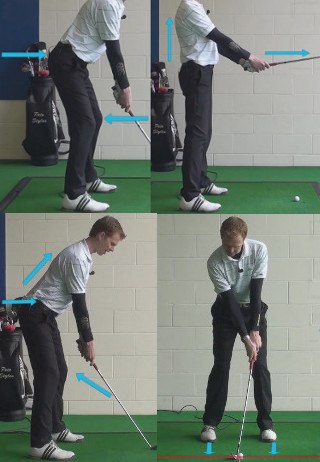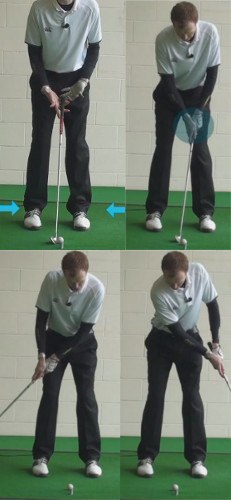To get started, we are going to first highlight the key fundamentals that all golfers should make sure are present when they stand over the ball. These aren't points that are up for debate – they are keys that would be agreed upon by (nearly) every golf teacher in the world. If you aren't hitting on all of these points when you stake your stance, you are making the game harder than it needs to be. It shouldn't take long to learn how to incorporate all of these keys into your setup, so there is no excuse for continuing to play without using these proper fundamentals.
While addressing the ball properly doesn't guarantee that you will make a good swing, it certainly is an important first step. A quality stance sets you up for success in the swing, so you will be well ahead of all the players who don't take the time to refine their setup appropriately.

In the game of golf, the success or failure of your shots will largely be determined before you even put the club in motion. Most players focus their practice efforts on the actual moving parts of the swing, but getting things right at address is just as important. Your setup position is going to have a lot to say about the quality of the shots you are able to hit in the end, so don’t overlook the importance of this component.
This article is going to focus on the various pieces that need to come together for you to create a quality setup position. One of the great things about the setup is that it doesn’t necessarily require any talent to get it right. Some people have more natural talent for this game – and athletic endeavors in general – than others, but that shouldn’t matter when it comes to the setup. As long as you are willing to practice and pay attention to the small details, you can set yourself into a great position shot after shot.
All of the content below is based on a right-handed golfer. If you happen to play left-handed, please take a moment to reverse the directions as necessary.
— Why the Setup Matters
| GOLF FIXES BY PGA PROS |
|---|
| Pitching Setup Lesson | Video | Article |
| Greenside Bunker Shots, The Correct Setup and Swing Golf | Video | Article |
| How Much Should Your Knees Bend in Setup, Swing? Golf Swing Tip | Video | Article |
| Basic Setup Lesson by PGA Pro Tom Stickney | Video | Article |
| Posture Setup Lesson by PGA Pro Tom Stickney | Video | Article |
| Improve your Posture with Simple Setup Method | Video | Article |
| Increase Power Setup with Shoulders Closed | Video | Article |
| Check Clubs, Setup to Prevent Contact On Toe | Video | Article |
| Check your Distance from the Golf Ball at Setup | Video | Article |
| Proper Golf Chipping Setup | Video | Article |
| Find The Right Golf Setup Distance For You | Video | Article |
| Perfect Golf Stance, Solid Base for Correct Setup | Video | Article |
| Golf Arm, Tips on Proper Setup and Alignment | Video | Article |
| Set Up Your Golf Shot: Athletic Golf Swing Begins with Setup | Video | Article |
| LESSONS |
|---|
| Putting Setup Lesson | Video | Article |
| Chipping Setup Lesson | Video | Article |
| Putting Setup Lesson | Video | Article |
| Ian Poulter Golf Pro: Unusual Setup, Exceptional Results | Video | Article |
| Bump And Run, The Correct Setup and Swing To Play Bump-and-Run Golf | Video | Article |
| Part 2 Golf Putter: Setup | Video | Article |
| Full Swing and Setup Lesson | Video | Article |
| Greenside Bunker Setup Lesson | Video | Article |
| Chipping Setup – Lesson | Video | Article |
| Pitching Setup Lesson | Video | Article |
| Putting Setup Lesson | Video | Article |
| YOUR GRIP |
|---|
| How to Setup for a Cross Handed Putting Grip Style Ladies Putter Tip | Video | Article |
| PRACTICE DRILLS |
|---|
| Credit card in back of glove to check setup, Golf Drill | Video | Article |
| Right Hand Golf Tip: What is the Best and Correct Chipping Setup | Video | Article |
| Tee Peg in top of grip for good setup | Video | Article |
| GOLF QUESTIONS |
|---|
| Golf Setup, Where Should My Right Foot Position Be? | Video | Article |
| Putting Setup, Eyes In Relation To The Golf Ball | Video | Article |
| Golf Ball Above Feet, What Should I Change In My Setup? | Video | Article |
| Golf Ball Below Feet, What Should I Change In My Golf Setup? | Video | Article |
| Wedge Setup, What Is The Best Set Up For Wedge Shots | Video | Article |
| Golf Draw, How To Setup To Help In Drawing The Ball | Video | Article |
| What Are The Key Putting Check Points In My Setup | Video | Article |
| Golf Fade, How Should I Make Adjustments To My Setup | Video | Article |
| Golf Setup, Should I Lock My Right Arm? | Video | Article |
| Golf Setup, What Is The Perfect Set Up For Great Iron Shots | Video | Article |
The setup position is the foundation for the golf swing. If you haven’t been paying much attention to this part of your game previously, you would be wise to take it seriously moving forward. If it helps you get motivated, try thinking about the setup position in the same way you would think of the foundation of a house. A house built on a crooked or faulty foundation would be destined to run into problems, and the same can be said for the relationship between your setup and your swing. Without a great setup to start things off, it’s always going to be hard to produce the kind of swing you desire.
To get a little more specific, let’s look at three key points that highlight the importance of getting your setup just right.

- Start the backswing correctly. The takeaway phase of the backswing is incredibly important. If you can get things right in the first few inches of your backswing, it’s far more likely that things will keep going well all the way up to the top and through the transition. Unfortunately, a faulty setup can cause you to get off track right from the start, and you might not ever be able to recover. Rather than setting up to the ball in a way that is going to force you to make corrections, it would be better to find a position that naturally leads to a proper takeaway. In this way, a good setup can make the takeaway and the rest of the backswing feel easier, and you’ll be a big step closer to hitting good shots.
- Balanced from the beginning. You may already be aware of how important balance is in the golf swing. Simply put, if you want to consistently hit good shots, you need to be balanced from start to finish. Many golfers struggle with balance, and those issues often start before the swing even gets going. If you aren’t doing things right in your setup to promote good balance, it will be difficult – or even impossible – to stay balanced once the swing gets going. It’s easy to overlook the importance of balance in the golf swing with so many other things to worry about, but don’t fall into that trap. If you are able to focus on mastering the art of golf swing balance, you’ll come away as a much better ball striker in the long run.
- Consistency is essential in golf. There are few things in golf more important than the ability to repeat your shots over and over again. While many golfers are obsessed with hitting the ball as far as possible, sheer distance actually isn’t going to do you a lot of good – unless it is properly controlled. Even short hitters can shoot great scores if they are able to repeat their ball flights consistently and accurately. To work toward improved consistency, optimizing your setup is an important step. With a solid setup position, and the same setup position before each swing, you should see great progress in the area of consistency. It’s a great feeling to know that the ball is going to come off the club roughly as you expect after each swing, and improving your setup is one of the best ways to reach that level of confidence.
- Make yourself comfortable. It’s relatively easy to feel comfortable with your golf swing on the practice range. There really isn’t anything on the line, so you just swing away and see where each shot goes. You are trying to hit good shots, of course, but it isn’t a big deal if you hit a few bad ones. On the course, however, the stakes are raised, and you’ll be more likely to feel uncomfortable and nervous. With that being the case, it’s helpful to use a solid setup position to put your mind at ease and make you feel comfortable with the swing that you are about to make. This little boost of confidence can be the difference between making a great swing and hitting a poor shot.
It you ever watch golf on TV, be sure to pay attention to how each golfer manages his or her setup position. You’ll notice that the setup of a pro golfer doesn’t change from shot to shot, unless an unusual lie or situation requires them to adjust. If you can develop that kind of setup consistency in your own game, you’ll be a better player for the effort.
— Five Keys to the Setup
We mentioned earlier that you can learn from watching golf on TV. When you watch, you’ll also notice that there are no two setup positions which are exactly alike. Sure, some golfers look similar over the ball, but each player has their own way of preparing to make a swing. So, knowing that, you shouldn’t feel obligated to match your setup position to any type of model. You are free to do your own thing – provided you hit on some important key points.
Below, we have listed five keys that you should watch for as you build your stance.

- Flexed knees. Flexing your knees at address offers several important benefits. For starters, adding knee flex helps you to get balanced, and it helps you to stay balanced as the swing develops. Also, when your knees are flexed, the large muscles in your legs are naturally engaged – meaning they will be ready to jump into action when it is their turn to help with the swing. Players who stand over the ball with their legs in a straight position struggle to get any help from their lower body, and those players lack swing speed as a result. As you work on your setup position, spend some time on the range experimenting with various amounts of knee flex. Some players will feel most comfortable with just a bit of flex, while others will like to sit down further into their address position. There is no right answer for how much knee flex you should use, as long as you have at least a little bit when you take your stance. Once you figure out how much knee flex works for you, do your best to repeat that same position over and over again.
- Flat back position. You don’t want to be hunched over the ball when taking your stance. The golf swing is a rotational move, so you will want to get the best possible shoulder turn when moving the club back and through. It’s hard to turn your shoulders fully when you are hunched over, so keeping your back in a flat position is a point worthy of a spot on our list. Fortunately, the first point on our list – flexing your knees – will actually help you flatten out your back. As you sit down into your stance, feel like you are sticking your backside out behind you a little bit. That will flatten out the lower part of your back, so then all you need to do is keep your shoulders up and maintain good posture as you tilt out over the ball. To get comfortable with this position, try practicing your stance in front of a mirror without a club. Stand near a large mirror, with the mirror to your left so you can see your profile. Settle down into a stance and then turn your head to see how your back looks. If it is mostly flat from your waist up to your neck, you have done a good job on this point.
- Chin up. This point goes right along with the previous point about keeping your back flat. To help avoid hunching over from the shoulders, and to make it easier to make a free turn, you’ll want to keep your chin well up away from your chest at address. Many golfers get this one wrong, thinking they need to ‘keep their head down’ as they have been told so many times by so many people. Keeping your head down doesn’t mean forcing it down into your chest when you take your stance – it just means not lifting up early as you swing through the hitting area. As part of your standard address position, be sure to keep your chin up comfortably away from your chest, flattening the top of your back and making room for your shoulder turn. You should still be keeping your eyes down on the ball, of course, so you can clearly see what you are trying to hit.
- Alter the width of your stance. For the vast majority of your shots, the stance you take over the ball is going to look very similar. Unless you draw a poor lie or are trying to hit some kind of unusual shot to deal with the situation at hand, you’ll be using a ‘stock’ stance for most occasions. So, the fundamentals of your stance like a flat back and flexed knees aren’t going to vary much. However, you do need to adjust the width of your stance from shot to shot depending on the club you are using. As a general rule of thumb, your stance should get wider as the club gets longer. So, you’ll use a relatively narrow stance with your wedges – maybe shoulder width apart or so – and a much wider stance when swinging a driver. Finding the right stance width come down to experimentation and practice, so make sure to spend some time on this point at the range until you dial it in just right.
- Keep it moving. It’s easy to think of your stance as a static position, but that’s not really the case. In reality, you should keep yourself moving – if only slightly – right up until the point when you start the swing. If you try to stand perfectly still over the ball until the swing begins, you are going to get tight and you may find it difficult to create any rhythm in your swing. Rather than standing like a statue, make it a point to build some slightly movement into your stance. This movement can take on a variety of forms, so work on your own style until you settle on something that feels comfortable. For instance, some golfers like to ‘waggle’ the club head as they settle into their stance, which just means they move the club head around a bit behind the ball. Whatever you do to keep your body loose and relaxed, make sure it feels natural and gives you the confidence necessary to start your swing properly time after time.
As you can see from the list above, you have plenty to work on with regard to your setup position. Remember, nothing happens by accident in golf – if you want to get better, you need to put in the work. Check off the points above one at a time until your new stance is in place and ready to take you to new heights on the course.
— Getting Comfortable
Something that frustrates many golfers is the fact that they struggle to play better golf even after making technical improvements on the range. There are a variety of reasons that you might find lower scores hard to come by, but one common issue is simply not feeling comfortable. If you don’t feel comfortable standing over the ball on the course, it’s going to be hard to hit the kinds of shots you need to achieve those lower scores you’ve been dreaming of.

It’s particularly difficult to get comfortable after you have made a change to your setup position. Whether you realized it or not, your setup position was a natural part of your game that you didn’t have to think much about previously. Even if it wasn’t technically sound, it felt comfortable and probably gave you some measure of confidence. To allow your new setup to work to its full potential, you will need to find a way to make it feel completely comfortable and second nature.
The obvious place to start in that pursuit is to hit as many golf balls as possible at the range. With each shot you hit out of your new stance, you will gain a little bit of confidence. It’ll take more than a couple of range sessions to get comfortable, of course, but keep chipping away at it and you’ll gradually start to trust this new position more and more.
Also, when you are away from the range, you can practice just by putting your body into the address position – even without a club in your hands. If you have a couple of minutes free at home, take your stance a few times and maybe check it in a mirror while you’re at it. Making the most of your free time is a good way to keep the progress going even when you can’t get to the range for an actual practice session.
— Putting Setup Keys
In some ways, the setup you use in the short game is going to be similar to what you do with your full swing. It’s not going to be exactly the same, however, particularly when you are putting. With this last section, we’d like to highlight some of the key setup points for your putting stroke, so you can hopefully make some progress with that piece of your game, as well.
Before we start with our list, it’s important to point out that there is more individual freedom and style within the putting stroke as any other part of the game. In other words, the points below are suggestions, not rules. You may find that most of these points work for you while one or two don’t quite feel right or lead to good results. And that’s okay. Get out on the practice green and experiment with your stroke until you find something that consistently sends the ball to the bottom of the hole.

- Eyes over the ball. This is a great starting point for building a putting stance. When you make a full swing, your eyes are going to be well to the inside of the position of the ball, due to the length and lie angle of the club you are swinging. That doesn’t need to be the case with the putter. Your putter is likely the shortest club in your bag, and the most upright. So, you can get your head out over the ball at address more than on any other shot. Try positioning your eyes either directly over the ball, or just slightly to the inside of that line. This will give you a great look at the ball as the putter swings, and it should make it easier to control the stroke by just rocking your shoulders back and through.
- Soft hands at address. You are going to struggle to control the speed of your putts properly if you hold onto the handle too tightly at address. Doing so is a classic mistake, and one that plagues countless average golfers. You aren’t swinging the putter very hard, or very fast, so you can get away with using a rather light grip pressure for most of your putts. Hold the club very lightly in your hands and let the rocking motion of your shoulders guide the putter back and through. Keeping your hands soft on the grip will improve your touch on the greens and help you find a square club face position at impact.
- Your feet are up to you. As you build your setup position, understand that you have a lot of latitude with regard to how your place your feet prior to each stroke. For some golfers, the best option is to stick with a traditional stance, where the feet are square to the target line. That’s not the case for everyone, however, as some players like to stand a bit open or a bit closed. You aren’t allowed to straddle the putting line – that’s against the rules – but you can otherwise experiment with a variety of stances until you find a comfortable position from which to putt. Remember, the whole point of practice is to figure out what works and what doesn’t, so don’t hesitate to try different things on the practice green as you search for a reliable stroke.
By taking time to work on your setup position, you will be providing yourself with a significant advantage over the competition on the course. Most golfers don’t take the time or effort necessary to work on this part of the game, and their results speak for themselves. Make it a point to work on your setup position during upcoming practice sessions and you will hopefully see the results of your work show up on the course in the near future.






